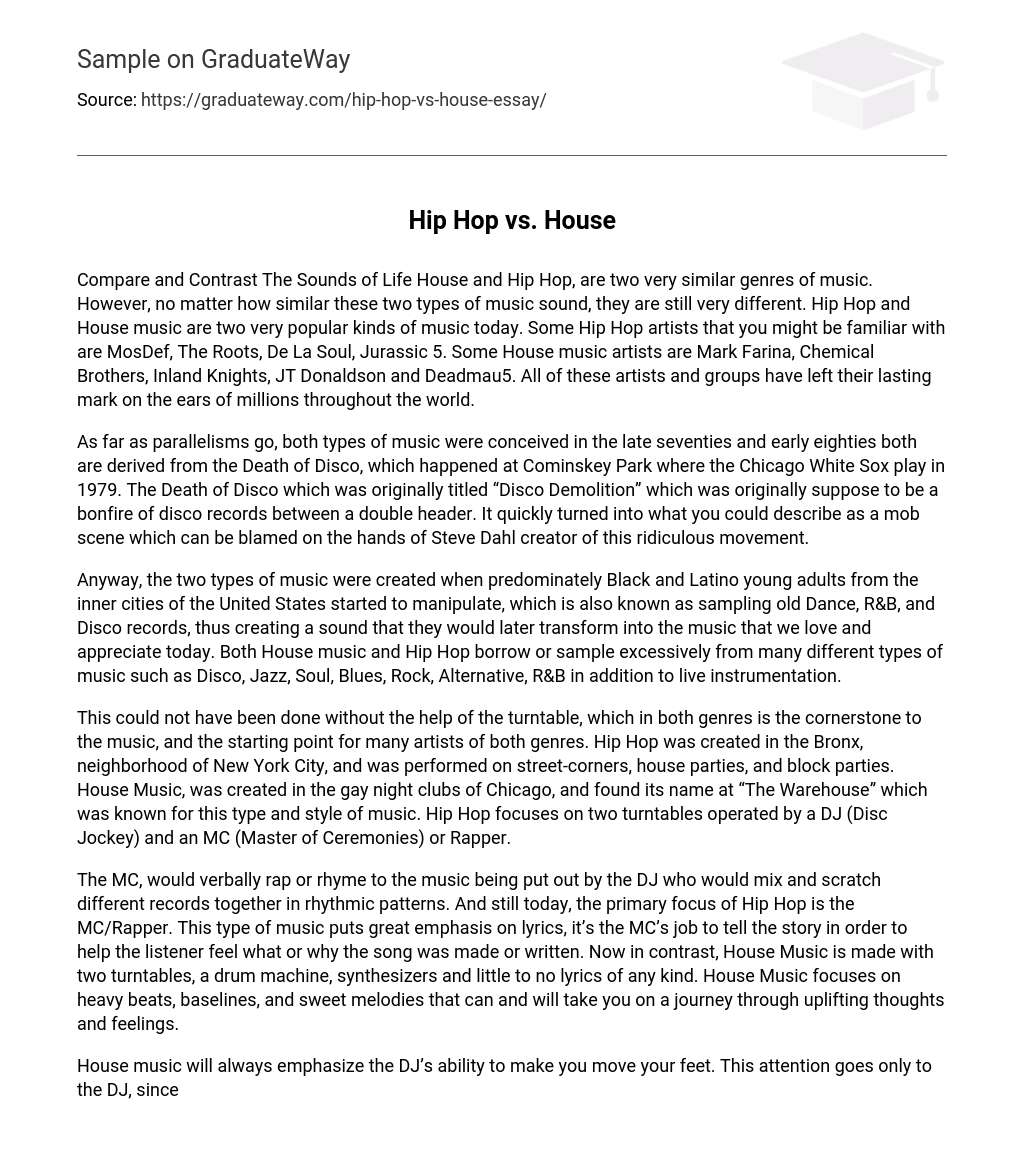Both House and Hip Hop are popular genres of music with similarities and differences. In today’s music scene, both genres have gained wide popularity. Notable artists in the Hip Hop genre include Mos Def, The Roots, De La Soul, and Jurassic 5. Conversely, House music is represented by artists such as Mark Farina, Chemical Brothers, Inland Knights, JT Donaldson, and Deadmau5. These talented individuals and groups have made a lasting impact on audiences worldwide.
Both Punk and Hip Hop music originated in the late 1970s and early 1980s as a result of the Death of Disco incident at Cominskey Park, the home stadium of the Chicago White Sox, in 1979. The event, originally named “Disco Demolition,” was initially intended to be a bonfire where disco records would be set on fire during a doubleheader game. However, it quickly turned into a chaotic scene resembling a mob. Steve Dahl played a significant role in driving this unconventional movement.
Both House music and Hip Hop originated from the innovation of mainly Black and Latino youth in inner cities in the United States. They accomplished this by manipulating old Dance, R&B, and Disco records, leading to a sound that is now cherished and admired. These genres heavily depend on borrowing or sampling from various musical styles such as Disco, Jazz, Soul, Blues, Rock, Alternative, R&B while also incorporating live instruments.
The turntable is an essential element in both hip hop and house music genres, acting as the backbone of the music and a starting point for many artists. Hip hop originated in New York City’s Bronx borough and was performed at various locations like street corners, house parties, and block parties. Conversely, house music emerged from Chicago’s gay nightclubs and gained its name from “The Warehouse,” a renowned venue for this genre. In hip hop, the focus is on two turntables operated by a DJ (Disc Jockey) alongside an MC (Master of Ceremonies) or Rapper.
The MC is responsible for verbally rapping or rhyming to the music provided by the DJ, who mixes and scratches different records in rhythmic patterns. Even today, the main focus of Hip Hop remains the MC or rapper, with lyrics playing a crucial role. The MC’s job is to tell the story and evoke emotions in the listener. In contrast, House Music is created using two turntables, a drum machine, synthesizers, and minimal to no lyrics. The genre emphasizes heavy beats, baselines, and soothing melodies that can transport listeners on an uplifting journey.
House music typically focuses on the DJ’s skill in getting people to dance. Unlike other genres, such as hip hop, there are no other performers to share the credit or attention in the DJ booth. Hip hop, with its slower tempo of 84-120 beats per minute (BPM), features a combination of a kick drum, high hat, and a snare. This allows the MC to rap along to the beat and deliver clear rhymes that listeners can easily follow and understand.
House music is known for its faster tempo, which typically ranges from 118 to 135 BPM. It incorporates a 4 on the floor beat that can be found in disco and electronic dance music, featuring a steady bass drum played uniformly in 4/4 time. Its purpose is to enhance the dancing experience. In contrast, Hip Hop focuses on MCs’ rivalries, often representing the East Coast or West Coast as they compete with each other to establish superiority through various means. In comparison, House music aims to unite people through love and understanding by promoting inclusivity regardless of race, beliefs, origin, or sexual orientation.
“Rappers Delight” by “The Sugar Hill Gang” was released in 1979, and it played a significant role in introducing Hip Hop to the entire nation. To this day, this iconic song remains a staple at clubs and parties, solidifying its status as an enduring hit. Consequently, the popularity of Hip Hop music has skyrocketed on national charts and made it one of the dominant genres globally. Likewise, House Music has transcended continents and is now widely enjoyed beyond the borders of the United States.
Despite not being widely accepted as a mainstream alternative to traditional American music, electronic dance music (EDM) has achieved worldwide popularity and influenced DJs to become celebrities. It can be heard globally, from Japan and Europe to South America and Australia, shaping our lives and serving as the background music for our experiences. Surprisingly, the histories of EDM and American music share similarities despite their different journeys. Both genres offer immense enjoyment, and I encourage everyone to fully explore both, allowing these beloved American treasures to captivate their hearts and ears.





